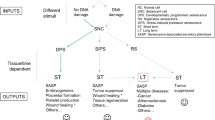Abstract.
One characteristic feature of senescent fibroblasts is flat, enlarged, and heterogeneous cell shapes. The present study was aimed to understand the structural basis of the senescent cell morphology. SDS-gel electrophoresis as well as western blotting demonstrated that there occurred a prominent protein band about 57 kDa in the senescent cells as compared with normal young or immortalized cells growing rapidly, and the protein was identified with a cytoskeletal protein, vimentin. In fact, senescent fibroblasts contained approximately threefold more vimentin protein, and fourfold more vimentin mRNA than young embryonic fibroblasts. In the senescent cells, vimentin cytoskeleton occurred as densely bundled filaments in parallel with the long axis of cell bodies, whereas in young or actively growing cells it showed short and thin vimentin filaments or fur-like irregular networks. It was further demonstrated that senescent cell shapes could be induced when a vimentin expression construct was transfected in young fibroblasts. These results suggest that senescent fibroblasts overproduce vimentin protein, and the overproduced vimentin filaments bring about the senescent cell morphology.
Similar content being viewed by others
Author information
Authors and Affiliations
Additional information
Electronic Publication
Rights and permissions
About this article
Cite this article
Nishio, K., Inoue, A., Qiao, S. et al. Senescence and cytoskeleton: overproduction of vimentin induces senescent-like morphology in human fibroblasts. Histochem Cell Biol 116, 321–327 (2001). https://doi.org/10.1007/s004180100325
Accepted:
Published:
Issue Date:
DOI: https://doi.org/10.1007/s004180100325




